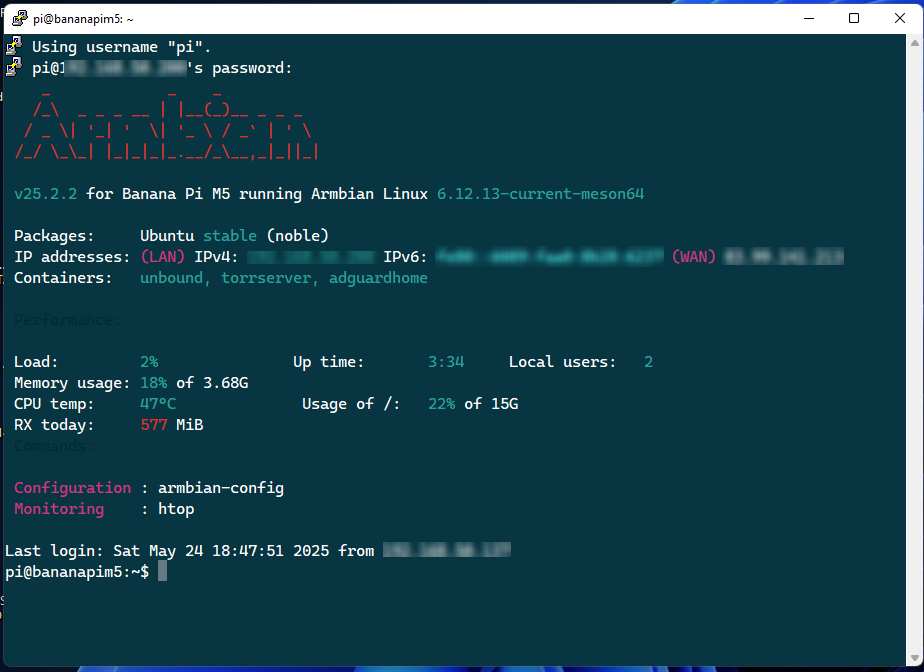All Activity
- Past hour
-
Hi! I'm new here too. I tested my webcam using webcammictest.io, and it worked fine, so the hardware seems okay. If you're encountering the "Inappropriate ioctl for device" error with v4l2-ctl, it might be due to driver compatibility issues or kernel differences. You could try using a different Armbian version, like Jammy, to see if that resolves the problem
- Today
-
Hi there, I'm seeing the same while trying to update some U-Boot bootscripts on my Helios4 (rockchip aarch64). Seems there needs to be more space between $kernel_load_addr_r and $ramdisk_addr_r. How much is a bit puzzling, as for other archs it's usually enough to count the kernel's image size (and some alignment). If i come across something interesting, I will share here too. Groetjes,
- Yesterday
-
I could solve the instability problems and I am using the 2.5Gbit port now without having errors and with full speed! changing the swich Flow Control On for 2.5Gbit devices ethtool -K <LAN-device> sg off sudo ip link set dev <LAN device> mtu 9000 using the actual dtb file posted above cp rk3399-kobol-helios64.dtb /boot/dtb/rockchip/ update-initramfs -u nano /etc/default/cpufrequtils ENABLE=true MIN_SPEED=600000 MAX_SPEED=1800000 GOVERNOR=ondemand nano /etc/rc.local for cpufreqpolicy in 0 4 ; do echo 1 > policy${cpufreqpolicy}/ondemand/io_is_busy echo 25 > policy${cpufreqpolicy}/ondemand/up_threshold echo 10 > policy${cpufreqpolicy}/ondemand/sampling_down_factor echo $(cat policy${cpufreqpolicy}/cpuinfo_transition_latency) > policy${cpufreqpolicy}/ondemand/sampling_rate done for i in $(awk -F":" "/ahci/ {print \$1}" < /proc/interrupts | sed 's/\ //g'); do echo 10 > /proc/irq/$i/smp_affinity done for i in $(awk -F":" "/xhci/ {print \$1}" < /proc/interrupts | sed 's/\ //g'); do echo 20 > /proc/irq/$i/smp_affinity done exit 0 nano /usr/local/bin/make_nas_processes_faster.sh #!/bin/sh -e for i in `pgrep "iperf3|smb"` ; do ionice -c1 -p $i ; taskset -c -p 4 $i; done # >/dev/null 2>&1 running as a service
-
Is there a way to copy the system from sda1 [M2-Sata SSD (2280)] to emmc (uboot) from the running system without losing the configuration? If it's possible, how can I do this including configuring the changes? What is the maximum size for the M2-Sata SSD (2280)? https://wiki.kobol.io/helios64/m2/
-
Hello, With kernel 6.6.56-current-rockchip64 the audio works correctly: cat /proc/asound/cards 0 [RK809 ]: simple-card - Analog RK809 Analog RK809 1 [HDMI ]: simple-card - HDMI HDMI With kernel 6.12.30-current-rockchip64 the RK809 card is not available: cat /proc/asound/cards 0 [HDMI ]: simple-card - HDMI HDMI How can this be solved ? Thank you so much !
-

Build Image with Debian 12 VM on QubesOS
Werner replied to joejoe44's topic in Advanced users - Development
openssh-server should be installed by default on all images/configurations. -
thanks again, I'll do this soon.
-

Build Image with Debian 12 VM on QubesOS
joejoe44 replied to joejoe44's topic in Advanced users - Development
By exiting the docker container and installing qemu-user-static in the host system, I was able to run the build again and progress. Appreciate the tip thank you! One final issue that I notice is when I am attempting to use customize-image.sh to install openssh-server package. As you can see by these logs it reaches "Setting up openssh-server (1:9.2p1-2+deb12u6) ..." but then script hangs and never progresses. [🐳|🔨] Fetched 13.0 MB in 5s (2,701 kB/s) [🐳|🔨] Reading package lists... [🐳|🔨] Reading package lists... [🐳|🔨] Building dependency tree... [🐳|🔨] Reading state information... [🐳|🔨] The following additional packages will be installed: [🐳|🔨] libssl3 (3.0.16-1~deb12u1) [🐳|🔨] openssh-client (1:9.2p1-2+deb12u6) [🐳|🔨] openssh-sftp-server (1:9.2p1-2+deb12u6) [🐳|🔨] openssl (3.0.16-1~deb12u1) [🐳|🔨] Suggested packages: [🐳|🔨] keychain (2.8.5-3) [🐳|🔨] libpam-ssh [🐳|🔨] monkeysphere [🐳|🔨] ssh-askpass (1:1.2.4.1-16) [🐳|🔨] molly-guard (0.7.2) [🐳|🔨] ufw (0.36.2-1) [🐳|🔨] Recommended packages: [🐳|🔨] xauth (1:1.1.2-1) [🐳|🔨] The following packages will be upgraded: [🐳|🔨] libssl3 (3.0.15-1~deb12u1 => 3.0.16-1~deb12u1) [🐳|🔨] openssh-client (1:9.2p1-2+deb12u5 => 1:9.2p1-2+deb12u6) [🐳|🔨] openssh-server (1:9.2p1-2+deb12u5 => 1:9.2p1-2+deb12u6) [🐳|🔨] openssh-sftp-server (1:9.2p1-2+deb12u5 => 1:9.2p1-2+deb12u6) [🐳|🔨] openssl (3.0.15-1~deb12u1 => 3.0.16-1~deb12u1) [🐳|🔨] 5 upgraded, 0 newly installed, 0 to remove and 17 not upgraded. [🐳|🔨] Need to get 4,617 kB of archives. [🐳|🔨] After this operation, 1,024 B of additional disk space will be used. [🐳|🔨] Get:1 http://deb.debian.org/debian bookworm/main arm64 libssl3 arm64 3.0.16-1~deb12u1 [1,812 kB] [🐳|🔨] Get:2 http://deb.debian.org/debian bookworm/main arm64 openssh-sftp-server arm64 1:9.2p1-2+deb12u6 [60.7 kB] [🐳|🔨] Get:3 http://deb.debian.org/debian bookworm/main arm64 openssh-server arm64 1:9.2p1-2+deb12u6 [413 kB] [🐳|🔨] Get:4 http://deb.debian.org/debian bookworm/main arm64 openssh-client arm64 1:9.2p1-2+deb12u6 [937 kB] [🐳|🔨] Get:5 http://deb.debian.org/debian bookworm/main arm64 openssl arm64 3.0.16-1~deb12u1 [1,395 kB] [🐳|🔨] Preconfiguring packages ... [🐳|🔨] Fetched 4,617 kB in 1s (6,157 kB/s) (Reading database ... 26620 files and directories currently installed.)e ... [🐳|🔨] Preparing to unpack .../libssl3_3.0.16-1~deb12u1_arm64.deb ... [🐳|🔨] Unpacking libssl3:arm64 (3.0.16-1~deb12u1) over (3.0.15-1~deb12u1) ... [🐳|🔨] Preparing to unpack .../openssh-sftp-server_1%3a9.2p1-2+deb12u6_arm64.deb ... [🐳|🔨] Unpacking openssh-sftp-server (1:9.2p1-2+deb12u6) over (1:9.2p1-2+deb12u5) ... [🐳|🔨] Preparing to unpack .../openssh-server_1%3a9.2p1-2+deb12u6_arm64.deb ... [🐳|🔨] Unpacking openssh-server (1:9.2p1-2+deb12u6) over (1:9.2p1-2+deb12u5) ... [🐳|🔨] Preparing to unpack .../openssh-client_1%3a9.2p1-2+deb12u6_arm64.deb ... [🐳|🔨] Unpacking openssh-client (1:9.2p1-2+deb12u6) over (1:9.2p1-2+deb12u5) ... [🐳|🔨] Preparing to unpack .../openssl_3.0.16-1~deb12u1_arm64.deb ... [🐳|🔨] Unpacking openssl (3.0.16-1~deb12u1) over (3.0.15-1~deb12u1) ... [🐳|🔨] Setting up libssl3:arm64 (3.0.16-1~deb12u1) ... [🐳|🔨] Setting up openssl (3.0.16-1~deb12u1) ... [🐳|🔨] Setting up openssh-client (1:9.2p1-2+deb12u6) ... [🐳|🔨] Setting up openssh-sftp-server (1:9.2p1-2+deb12u6) ... [🐳|🔨] Setting up openssh-server (1:9.2p1-2+deb12u6) ... The command used in customize-image.sh to install is simply: apt-get install -y open-ssh Since I used the -y flag I don't think any user input is needed, so not sure yet what I am missing. Any tips are greatly appreciate as I troubleshoot. Other than this issue with openssh-server, the build worked out ok! I will write some guides and share for other Qubes OS users. -
chatgpt advised to type ":UTC" or ":Europe/Berlin" and it helped.
-
Same answer as above. Without serial logs impossible to debug. It leaves to mention that this board is not officially supported but configuration has been provided by a community effort. Board status is unknown to the core Armbian team.
-

Very simple module for nothing, Segmentation fault
going replied to Kopia's topic in Allwinner sunxi
No. Yes. This is the most stable and well-developed kernel. -
kernel_ramfs is located at /dev/block/mmcblk2p6 Have extracted with dd and copying through wifi adb. Interesting usb debugging is enabled in tvbox, but when connecting usb v3 cable to tvbox, host machine does not see the 'adb device', adb connection over wifi is ok. Has anybody used USB adb on this device?
-
No, that won’t work. This is a Armbian Linux forum. If you need android support try xda forums.
-
I also encountered the same situation. I wrote the Ubuntu Orange Pi 5 Max image from the Orange Pi homepage (http://www.orangepi.org/) and it ran normally, but when I wrote the Armbian Ubuntu version from https://www.armbian.com/orangepi-5-max/, the indicator light was only green and nothing appeared on the screen. I also tried writing the Armbian version for the regular Orange Pi 5 or Orange Pi 5 Pro and it could run (although wifi and usb were lost, but I could boot to the desktop), but when I wrote the Armbian version for the Orange Pi 5 Max, it did not run. Is it a bootloader problem?
-
I found that sun50i-h618-transpeed-8k618-t.dtb is the working one, can I replace boot.img-dtb in the android img with it?
-
@jwillb00 there’s a drop down menu on the first page. You’ll see “main” as the first option. Select “v20250306” that’s my more recent and stable release. you can clone my build using git command. git clone https://github.com/NickAlilovic/build.git -branch v20250306 kernel config is located here. Edit the configuration manually. https://github.com/NickAlilovic/build/blob/v20250306/config/kernel/linux-sunxi64-edge.config To compile a new image use the commands cd build ./compile.sh choose "Do not change kernel configuration" choose "Show CSC/WIP/EOS/TVB" choose "I understand and agree" choose "tanix-tx6s-axp313" choose "edge" rest is up to you. Your image should be in output/images directory.
-
@Nick AI have been using the TX6s build and it's been working great, but I was curious about the structure of your repository. I saw no files for the TX6s, but I see images for it in the releases? I'm new to all this, but I need to change some kernel config options so I was wondering how I could apply those to your repository.
-
Well, i have jumped ship on gone to every os i can think of that will run on RPI5 and now IM BACK!!!! Hello again, Jayson Here - And i have decided that Arbian 25 Noble Gnome may be the smallest-strongest multimedia build i can find...so its what i will choose to finish my PI 5 with. I am still wrestling with the sony IMX477 as to produce video. I have just ordered a usb mount for uvc-video rather than csi/cam0-cam1 b/c i cant get it working. at all and need to advance... to the touchscreen which is still just HDMI w/o touch. on the new download of Armbian. its downloading now. I will put pics of the device and more tomorrow. Jay T.
-
Hi, I try to get my NanoPC-T4 a second life. Therefore I want to (re-) install Armbian but I'm stuck Andi don't know why. I uses USBFlasher to flash the minimal Armbian on it (tried compressed and uncompressed) but the green blinking light indicates me, that he found no bootable device. I tried different images as well. Also differen SD cards, even DietPi image, always the same. The only thing which runs instant is one of the eflasher Images of FriendlyARM. I also tried to change the image that the eflasher writes to the eMMC (by copy the uncompressed .img file to the SD card and renamed it to armbian.raw and changed the config file as the wiki said). While the flash process is working, it does not boot after that. I'm out of ideas... The final solution should be that has the bootloader on the eMMC while the rest of the os should be on the SSD, like it was before. I would be very thankful for help.
- Last week
-
Hi guys Just to thank you for the very relevant information I found in this forum. I am posting my experience with armbian. I successfully installed the unofficial armbian version "25.05.0 onecloud noble 6.12.17 xfce desktop" on a generic MXQ TV Box S805 with HTC-MXQ-V4 card. It was hard work! this box calls the aml_autoscript on boot... but need to be adjusted to allow booting. this procedure works for the board i mentioned, i don´t know about others. Use at your risk !!! But booting from SD is a relativelly safe procedure. download "Armbian-unofficial_25.05.0-trunk_Onecloud_noble_current_6.12.17_xfce_desktop.img.xz" uncompress the image (7zip) save to SDcard (8GB recomended) - I have used rufus Two partitions will be created. Two partiotions will be created ... first FAT32 (armbi_boot) and second EXT4 (armbi_root). On FAT32 partition (boot): file: aml_autoscript (copy commands below and put inside aml_autoscript.cmd) # Define boot only from SD Card setenv bootdev "mmc 0" # SD card # Load armbianEnv.txt fatload ${bootdev} 0x10800000 /armbianEnv.txt && env import -t 0x10800000 ${filesize} # Boot Arguments (provided by armbianEnv.txt) #setenv bootargs "" setenv bootargs "${bootargs} rootwait rw" setenv bootargs "${bootargs} ${consoleargs}" setenv bootargs "${bootargs} ${extraargs}" # Booting fatload ${bootdev} 0x14000000 /uImage || exit 1 fatload ${bootdev} 0x15000000 /uInitrd || exit 1 fatload ${bootdev} 0x11800000 /dtb/meson8b-onecloud.dtb || exit 1 bootm 0x14000000 0x15000000 0x11800000 file: armbianEnv.txt (copy parameters below and put inside armbianEnv.txt) consoleargs="console=ttyS0,115200n8 console=tty0 no_console_suspend splash=verbose" bootargs="root=LABEL=armbi_root" extraargs="loglevel=7 rootfstype=ext4 earlyprintk ip=dhcp" On Linux, put aml_autoscript.cmd on an directory and compile "mkimage -C none -A arm -T script -d aml_autoscript.cmd aml_autoscript" Copy both aml_autoscript.cmd and compiled aml_autoscript to root of FAT32 partition Adjust (with above parameters) or create a file and copy armbianEnv.txt to root of FAT32 partition. Rename "meson8b-mxq.dtb" to "meson8b-onecloud.dtb" to be compatible with same name defined on aml_autoscript (you could rename the file ou change the script ... choose) Boot from SDCard (Turn tvBox off, with a toothpick, click the button inside AV conector, hold down and turn on the TV box, hold the button for 5 to 15 seconds ) if everything went well the firt boot occur and your tvbox could boot from SD in armbian Linux with kernel 6.12 The first boot is extremelly slow... a lot of time... Good luck!!





